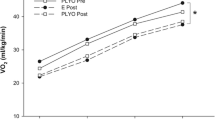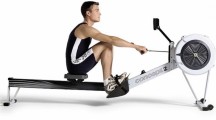Abstract
The relationship between power and gross efficiency during near-maximal rowing, and physiological measures of strength, power, aerobic and anaerobic capacities and United State Rowing Association (USRA) performance tests (independent variables) was investigated among collegiate male rowers. Criterion measures of rowing power and gross efficiency were measured in a moving-water rowing tank, using an oar instrumented with strain gauges to assess force and a potentiometer to assess oar position. Bivariate correlation analysis (n = 28) indicated no relationship between the independent variables and rowing gross efficiency (P > 0.05). Rowing power [mean (SD) 483.4 (34.75) W] was significantly related to inboard leg extension strength (IL strength, r = 0.63), outboard leg extension strength (r = 0.45), combined leg extension strength (r = 0.45), and time to complete the USRA 2000-m simulated rowing race (r = −0.52; P < 0.05). Stepwise regression using resampling cross-validation of 15 random samples (21 subjects per sample selected from a total group of 28 intercollegiate oarsmen) indicated that predictors of rowing power were IL strength and blood lactate following a peak oxygen uptake rowing test with significant multiple correlations of R = 0.61 to 0.86 (P < 0.05). The standard error of estimate (SEM) ranged from 18.1 to 29.9 W, or 5.3 (0.77)% of the criterion value. Cross-validation with a hold-out group (seven subjects per sample) was performed for each equation and correlations ranged from R = 0.14 to 0.97 (SEM = 8.0 to 38.9 W). In conclusion, data from the present study suggest that to increase rowing power, training should emphasize leg strength and anaerobic training to decrease the level of lactate accumulated during rowing.
Similar content being viewed by others
References
Asami T, Yamamoto K, Matsuo A, Fukunaga T (1985) Some biomechanical factors of rowing performance. In: Winter DA, Norman RW, Wells RP, Hayes KC, Patla AE (eds) Biomechanics IX-B Human Kinetics, Champaign, Ill., pp 477–480
Åstrand P-O, Rodahl K (1986) Textbook of work physiology, 3rd edn. McGraw-Hill, [New York
Cavanagh PR, Kram R (1985) The efficiency of human movement - a statement of the problem. Med Sci Sports Exerc 17:304–308
Cerretelli P, Binzoni T (1990) VI. The energetic significance of lactate accumulation in blood at altitude. Int J Sports Med 11:527–30
Dal Monte A, Komor A (1989) Rowing and sculling mechanics. In: Vaughan CL (ed) Biomechanics of sport. CRC Press, Boca Raton, pp 53–119
di Prampero PE (1981) Energetics of muscular exercise. Rev Physiol Biochem Pharmacol 89:143–222
di Prampero PE, Cortili G, Celentano F, Cerretelli P (1971) Physiological aspects of rowing. J Appl Physiol 31:853–857
Efron B, Gong G (1983) A leisurely look at the bootstrap, the jackknife, and cross-validation. Am Stat 37:36–48
Gladden LB, Welch HG (1978) Efficiency of anaerobic work. J Appl Physiol 44:564–570
Hagerman, RC (1984) Applied physiology of rowing. Sports Med 1:303–326
Hagerman RC, Addington WW, Gaensler EA (1972) A comparison of selected physiological variables among outstanding competitive oarsmen. J Sports Med 12:12–22
Hogan MC, Gladden LB, Kurdak SS, Poole DC (1995) Increased [lactate] in working dog muscle reduces tension development independent of pH. Med Sci Sports Exerc 27:371–377
Ishiko T, Katamoto S, Maeshima T (1983) Analysis of rowing movements with radiotelemetry. In: Matsun H, Kobayashi K (eds), Biomechanics VIII-B Human Kinetics, Champaign, Ill., pp 816–821
Jensen RL (1991) Relationship of peak blood lactate to decrease in power during six minutes of rowing exercise. Mod Sci Sports Exerc 23:534 [Abstr]
Jensen RL, Kline G (1994) The resampling cross-validation technique in exercise science: modelling rowing power. Med Sci Sports Exerc 26:929–933
Kearney JT, Van Handel PJ (1989) Economy: a physiologic perspective. In: Grana WA, Lombardo JA, Sharkey BJ, Stone JA (eds) Advances in sports medicine and fitness, vol 2. Year Book Medical Publishers, Chicago, pp 57–89
Malhotra MS, Verma SK, Gupta RK, Khanna GL (1984) Physiological basis for selection of competitive road cyclists. J Sports Mod 24:49–57
Margaria RA, Cerretelli P, di Prampero PE, Massari C, Torelli G (1963) Kinetics and mechanism of oxygen debt contraction in man. J Appl Physiol 18:371–377
Mason BR, Shakespear P, Doherty P (1988) The use of biomechanical analysis in rowing to monitor the effect of training. Excel 4:7–11
Nelson WN, Widule CJ (1983) Biomechanics: new frontier of rowing. Rowing USA 15:23–27
Pyke FS, Minikin BR, Woodman LR, Roberts AD, Wright TG (1979) Isokinetic strength and maximal oxygen uptake of trained oarsmen. Can J Appl Sports Sci 4:277–279
Schneider B, Angst F, Brandt AD (1978) Biomechanics in rowing. In: Asmussen E, Jorgensen K (eds) Biomechanics VI-B University Park Press, Baltimore, Md., pp 115–119
Secher NH (1983) The physiology of rowing. J Sports Sci 1:23–53
Steinacker JM (1993) Physiological aspects of rowing training. Int J Sports Med 14:S3-s10
Tabachnick BG, Fidell LS (1983) Using multivariate statistics. Harper and Row, New York
USRA (1990) National testing program. Stroke, March, p 7
Wood GA (1982) Data smoothing and differentiation procedures in biomechanics. In: Terjung RL (ed), Exercise and sports science reviews, vol 10. Franklin Institute Press, Syracuse, pp 308–362
Author information
Authors and Affiliations
Rights and permissions
About this article
Cite this article
Jensen, R.L., Freedson, P.S. & Hamill, J. The prediction of power and efficiency during near-maximal rowing. Europ. J. Appl. Physiol. 73, 98–104 (1996). https://doi.org/10.1007/BF00262816
Accepted:
Issue Date:
DOI: https://doi.org/10.1007/BF00262816




